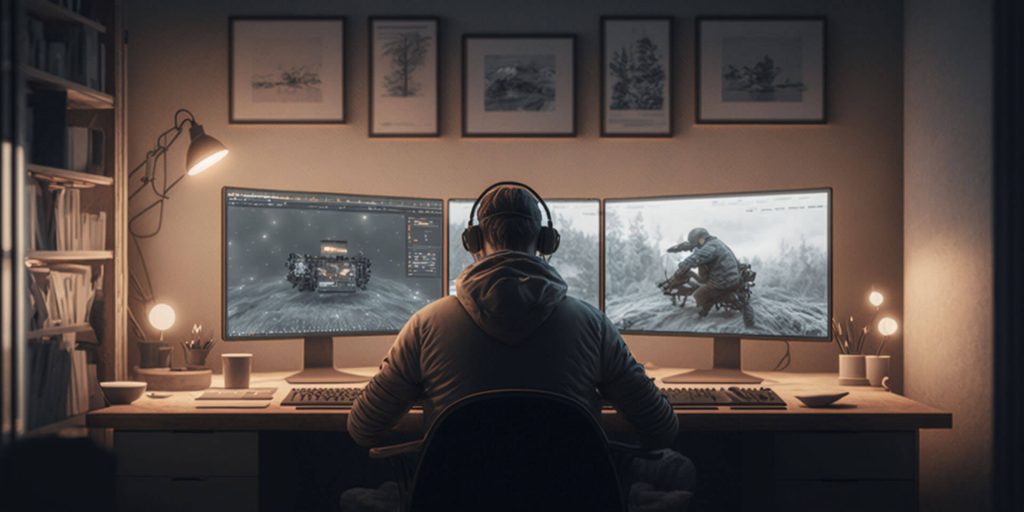If you’re looking for How Low Blue Light Monitor Can Help You Sleep, you came to the right spot.
In today’s world, electronic devices are an integral part of our daily lives.
From smartphones to laptops, we are constantly exposed to screens emitting light, which can affect our sleep quality.
Fortunately, there’s a solution to this problem – low blue light monitors.
In this article, we will explore the benefits of using a low-light monitor and how it can help you sleep better.
Feel free to check out our in-depth guide on the best monitors for eye strain
How a Low Blue Light Monitor Can Help You Sleep | Detailed Guide
A low blue light monitor is a type of computer monitor that emits less than a regular monitor.
It is a short-wavelength, high-energy light that is emitted by electronic devices, including computer monitors, smartphones, and tablets.
Exposure to blue waves of light at night can interfere with our circadian rhythms, making it difficult to fall asleep and stay asleep.
A low-light monitor can help reduce our exposure to blue light and improve our sleep quality.
How does a low-blue light monitor work?
A low quality monitor works by filtering out the harmful blue light emitted by electronic devices.
It does this by using a special type of backlight technology that emits less blue light.
Some monitors also come with software that can adjust the color temperature of the screen based on the time of day.
For example, the screen might be warmer and emit less in the evening to help prepare the body for sleep.
Benefits of using a low blue light monitor
Using a low quality monitor can have several benefits for our health and well-being, including:
- Improved sleep quality: Exposure at night can disrupt our circadian rhythms and make it difficult to fall asleep and stay asleep. By reducing our exposure, a low blue light monitor can help improve our sleep quality.
- Reduced eye strain: Ít can also cause eye strain and fatigue, especially when using electronic devices for extended periods. By reducing emission, a low blue light monitor can help reduce eye strain and improve visual comfort.
- Better mood: Exposure to blue light at night can also affect our mood and mental wellbeing. By improving our sleep quality, a low-emission monitor can help improve our mood and reduce the risk of depression and anxiety.
- Reduced risk of age-related macular degeneration (AMD): AMD is a common eye disease that can lead to vision loss. Exposure is a risk factor for AMD, but a low blue light monitor can help reduce this risk.
- Better productivity: By reducing eye strain and fatigue, a low emmission monitor can help improve productivity and reduce the risk of errors and mistakes.
How to choose a low blue light monitor
When choosing a monitor, there are a few things to consider:
- The amount of blue light emission: Look for a monitor that emits less than 30%. This will help ensure that you’re getting the full benefits of a low blue light monitor.
- The color accuracy: Make sure the monitor has good color accuracy and contrast, so you can enjoy high-quality images and videos.
- The size and resolution: Choose a monitor that suits your needs and preferences in terms of size and resolution.

FAQs
How does the visible light spectrum impact our sleep?
The visible light spectrum encompasses different colors, including blue light. Blue light can disrupt our sleep-wake cycle, particularly when exposed to it in the evening and at night, making it harder to fall asleep and affecting sleep quality.
Can blue light-blocking glasses be beneficial during the daytime?
Blue light-blocking glasses can be helpful during the daytime as well. They reduce exposure to blue light emitted by electronic devices and artificial lighting, promoting better sleep and overall well-being.
What are alternative methods to reduce blue light exposure apart from using blue light filters?
In addition to blue light filters, adjusting the brightness and color settings on electronic devices can help reduce blue light emissions. Some devices also offer features like night mode or night shift mode, which automatically reduce blue light during evening hours.
Can reducing blue light exposure have a positive impact on sleep disorders?
Research suggests that reducing blue light exposure, especially in the evening, can improve sleep disorders like insomnia. By blocking nocturnal blue light, our body’s natural sleep-wake cycle can be regulated, resulting in more restful sleep.
How does a low blue light monitor improve sleep?
Monitors reduce artificial blue light exposure from electronic devices, promoting a more natural sleep-wake cycle and better sleep quality.
Can blue light-blocking glasses provide similar benefits?
Blocking Blue Light glasses filter out harmful blue wavelengths, but a monitor offers a more comprehensive solution to reduce blue light exposure.
Are there other ways to reduce blue light exposure?
Yes, strategies like night mode settings, blue light filters/apps, limited screen time, and dim lighting in the bedroom can also minimize and support good sleep.
Conclusion
If you’re someone who spends a lot of time in front of a computer screen or other electronic devices, a monitor can be a great investment for your health and well-being.
By reducing blue light emission, a low blue light monitor can help improve your sleep quality, reduce eye strain, and even improve your mood.
When choosing a monitor, be sure to consider the amount of emission, color accuracy, size, and resolution to find the best option for your needs.
So, if you want to improve your sleep and reduce eye strain, consider investing in a low-blue light monitor today!
